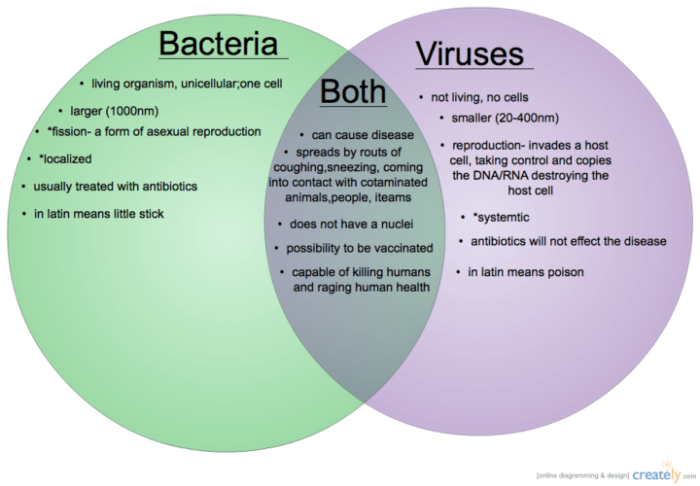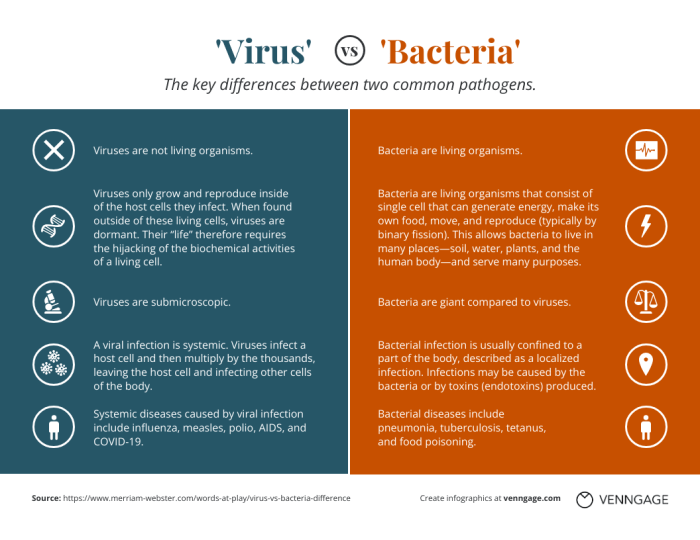Bacteria vs viruses venn diagram takes center stage as we delve into a captivating exploration of these two distinct microorganisms. From their fundamental characteristics to their intricate interactions with hosts, this diagram unveils a world of fascinating insights.
Through the lens of comparative analysis, we will uncover the remarkable similarities and striking differences between bacteria and viruses, shedding light on their unique roles in the realm of microbiology.
Bacteria vs. Viruses Venn Diagram
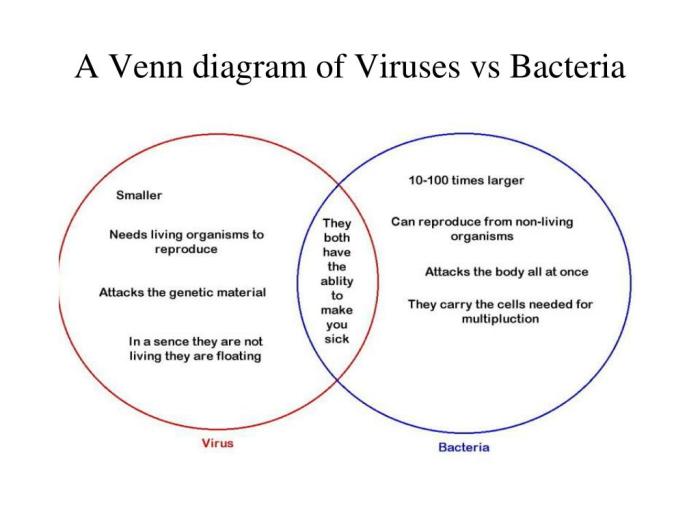
Bacteria and viruses are two distinct types of microorganisms with significant differences in their structure, genetic material, and mode of replication. Understanding the key characteristics of each group is essential for comprehending their role in various biological processes and their impact on human health.
Key Characteristics of Bacteria
- Prokaryotic cells: Lack a true nucleus and membrane-bound organelles.
- Cell wall: Composed of peptidoglycan, a complex carbohydrate.
- Ribosomes: 70S ribosomes for protein synthesis.
- Reproduction: Binary fission (asexual).
- Examples: Escherichia coli, Staphylococcus aureus
Key Characteristics of Viruses
- Non-cellular entities: Lack a cell wall, cytoplasm, and organelles.
- Genetic material: Either DNA or RNA, enclosed in a protein coat (capsid).
- Replication: Requires a host cell to replicate and assemble new viral particles.
- Transmission: Spread through contact with infected individuals or contaminated surfaces.
- Examples: Influenza virus, HIV, Ebola virus
Transmission and Replication
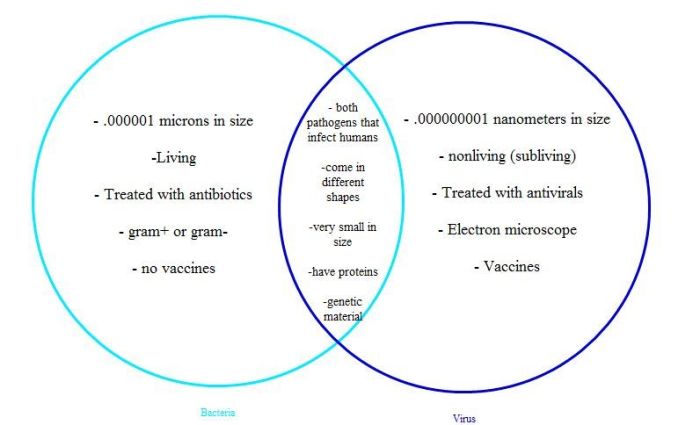
Transmission and replication are fundamental processes that define the behavior and impact of bacteria and viruses. These processes influence their spread, survival, and interactions with host organisms.
Transmission
- Bacteria:Bacteria can be transmitted through various routes, including contact with contaminated surfaces or objects, ingestion of contaminated food or water, and inhalation of airborne particles.
- Viruses:Viruses are obligate intracellular parasites and require a host cell to replicate. They can be transmitted through contact with infected individuals or animals, inhalation of respiratory droplets, or contact with contaminated surfaces.
Replication
The replication process differs significantly between bacteria and viruses.
Bacteria
- Binary Fission:Bacteria replicate asexually through binary fission, where the parent cell divides into two identical daughter cells.
- DNA Replication:Prior to division, the bacterial chromosome undergoes replication, ensuring each daughter cell receives a complete copy of the genetic material.
- Cell Division:The replicated chromosomes segregate to opposite ends of the cell, and the cell membrane pinches inward, dividing the cell into two.
Viruses
- Attachment:Viruses attach to specific receptors on the surface of host cells.
- Entry:The virus enters the host cell through various mechanisms, such as endocytosis or fusion with the cell membrane.
- Replication:Once inside the cell, the viral genome is released and replicated using the host cell’s machinery.
- Assembly:New viral particles are assembled from the replicated viral components.
- Release:The newly assembled viral particles are released from the host cell, either by budding or cell lysis.
Pathogenicity and Host-Pathogen Interactions
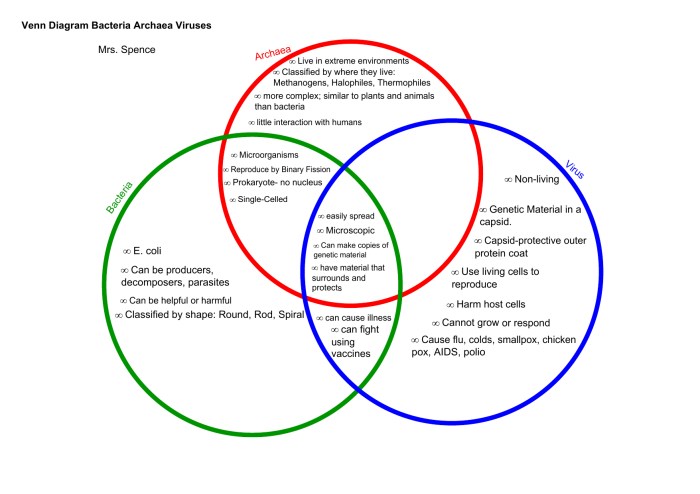
Pathogenicity refers to the ability of a microorganism to cause disease. Bacteria and viruses can cause disease through various mechanisms, including the production of toxins, enzymes, and other virulence factors that damage host tissues or disrupt normal physiological processes.
Types of Host-Pathogen Interactions, Bacteria vs viruses venn diagram
Host-pathogen interactions can be classified into different types based on the nature of the relationship between the host and the pathogen:
- Commensalism:A relationship in which one organism benefits from the association without harming the other. For example, some bacteria that reside on the human skin or in the gut provide benefits to the host, such as protection against harmful pathogens.
- Mutualism:A relationship in which both organisms benefit from the association. For example, some bacteria in the human gut produce vitamins that are essential for the host, while the bacteria benefit from the nutrients provided by the host.
- Parasitism:A relationship in which one organism (the parasite) benefits at the expense of the other (the host). Parasites can cause disease in the host by damaging tissues, consuming nutrients, or disrupting normal physiological processes.
Examples of Bacterial and Viral Diseases
Bacteria and viruses can cause a wide range of diseases, including:
- Bacterial diseases:Tuberculosis, pneumonia, strep throat, food poisoning, urinary tract infections
- Viral diseases:Influenza, common cold, measles, mumps, rubella, AIDS
The severity of the disease caused by a particular pathogen depends on factors such as the virulence of the pathogen, the immune status of the host, and the route of infection.
Applications in Biotechnology
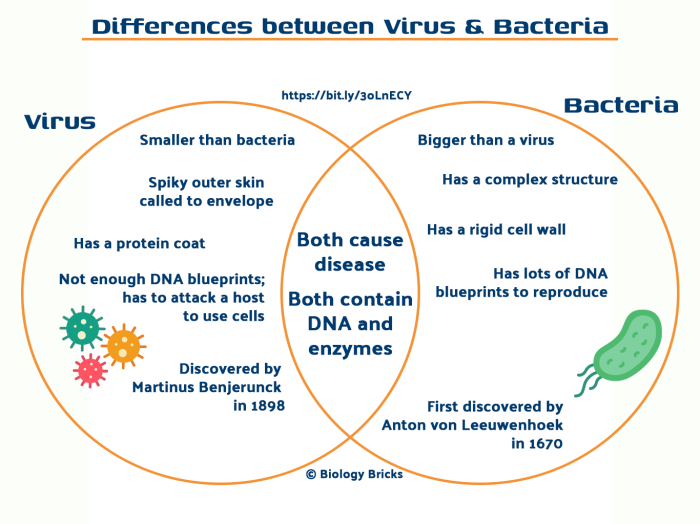
Bacteria and viruses play crucial roles in biotechnology, offering diverse applications in genetic engineering, industrial processes, environmental remediation, gene therapy, vaccine development, and nanotechnology.
Bacteria in Biotechnology
Bacteria are widely used in genetic engineering due to their ability to manipulate DNA. They are employed in cloning, protein production, and the development of genetically modified organisms (GMOs). In industrial processes, bacteria are used for fermentation, food production, and the synthesis of chemicals.
They also find application in environmental remediation, where they are employed to degrade pollutants and clean up contaminated sites.
Viruses in Biotechnology
Viruses have potential applications in gene therapy, where they are used to deliver therapeutic genes to target cells. They are also utilized in vaccine development, where they are modified to induce immunity against specific pathogens. In nanotechnology, viruses are used as templates for the fabrication of nanomaterials with unique properties.
Questions Often Asked: Bacteria Vs Viruses Venn Diagram
What is the key difference between bacteria and viruses?
Bacteria are living cells with a complex cellular structure, while viruses are non-living entities that require a host cell to replicate.
How are bacteria and viruses transmitted?
Bacteria can be transmitted through contact with contaminated surfaces or bodily fluids, while viruses are typically transmitted through respiratory droplets or contact with infected individuals.
What are the common treatments for bacterial and viral infections?
Bacterial infections are typically treated with antibiotics, while viral infections are treated with antiviral drugs.
